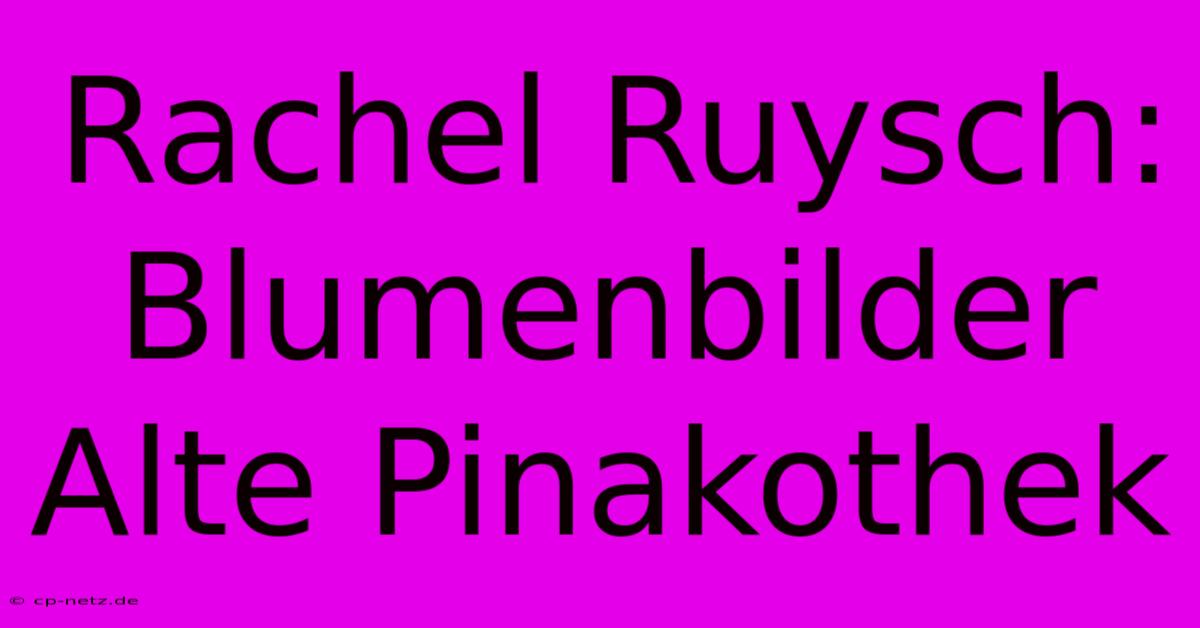Rachel Ruysch: Blumenbilder Alte Pinakothek

Discover more detailed and exciting information on our website. Click the link below to start your adventure: Visit Best Website Rachel Ruysch: Blumenbilder Alte Pinakothek. Don't miss out!
Table of Contents
Rachel Ruysch: Master of the Still Life - A Deep Dive into the Alte Pinakothek's Treasures
Hey everyone! So, I recently got totally obsessed with 17th-century Dutch still lifes, and let me tell you, Rachel Ruysch's work at the Alte Pinakothek in Munich blew me away. I mean, seriously – blown away. Before this, I kinda thought of still lifes as, well, just flowers in a vase. Boy, was I wrong. This wasn't just about pretty pictures; it was about symbolism, artistry, and a whole lotta skill.
My "Duh" Moment with Ruysch's Work
Initially, I just saw pretty flowers. I’d wandered into the Alte Pinakothek, you know, just browsing, and stumbled upon this room filled with these incredible paintings. I was mostly focused on the big, dramatic history paintings. It wasn't until I actually looked at Ruysch’s work – really looked – that I understood the depth. I felt like a total idiot for not appreciating them sooner. It's like I was missing the whole point. Talk about a "duh" moment!
The Intricate Detail: More Than Meets the Eye
Ruysch's paintings aren't just about pretty petals; they're packed with amazing detail. Think individual dew drops clinging to leaves, the subtle textures of different fabrics (she often included drapes or tablecloths), even the way light plays across the petals. The realism is astounding. I mean, you can practically smell the roses. It's incredible the way she captures the subtle textures and vibrant colors. I spent like, half an hour just staring at one painting, trying to figure out how she did it. There’s a reason why she's considered one of the greatest still life painters of the Dutch Golden Age, you know.
The Symbolism: Beyond the Beauty
What really impressed me, though, was the symbolism woven into her work. These weren't just random bouquets; each flower, each insect, each carefully placed element likely held a deeper meaning. Vanitas themes were popular at the time, reflecting on the fleeting nature of life. Things like wilting flowers, decaying fruits, or insects crawling on the blossoms could represent mortality. I’m still researching, to be honest, there is so much to learn about the symbolism. Many scholars debate the exact meaning behind her work. It's so complex, it's like reading a really, really intricate poem.
Tips for Appreciating Ruysch's Masterpieces (and Other Art!)
Here’s my advice for anyone planning a visit to the Alte Pinakothek to see Ruysch's paintings or any other art, for that matter:
- Do your research beforehand. Reading up on the artist, their style, and the historical context helps immensely. It totally changed my experience. You’ll understand so much more.
- Take your time. Don't rush through the gallery. Spend time with each painting, really observing the details. It's easy to get overwhelmed, but trust me, slower is better.
- Look for the details. Pay close attention to the brushstrokes, the colors, the way light and shadow are used. Ruysch's skill is just mind-blowing.
- Consider the symbolism. Think about what the elements in the painting might represent. What story is the artist trying to tell? This adds another whole layer of enjoyment.
Visiting the Alte Pinakothek to see Rachel Ruysch's work was a truly transformative experience. It made me appreciate the depth and complexity of still-life painting in a whole new way. If you have the chance to see her work, don't miss it! You might just be surprised by what you discover. I know I was!

Thank you for visiting our website wich cover about Rachel Ruysch: Blumenbilder Alte Pinakothek. We hope the information provided has been useful to you. Feel free to contact us if you have any questions or need further assistance. See you next time and dont miss to bookmark.
Featured Posts
-
De Ketelaere Glaenzt 2 Tore 3 Assists
Nov 27, 2024
-
Inter Siegt Gegen Leipzig In Der Champions League
Nov 27, 2024
-
Wirtz Glaenzt Bayer Besiegt Salzburg
Nov 27, 2024
-
Lisa Perstaller Vorbericht Salzburg
Nov 27, 2024
-
Stadionverbot Barcelonas Ultras Bestraft
Nov 27, 2024
